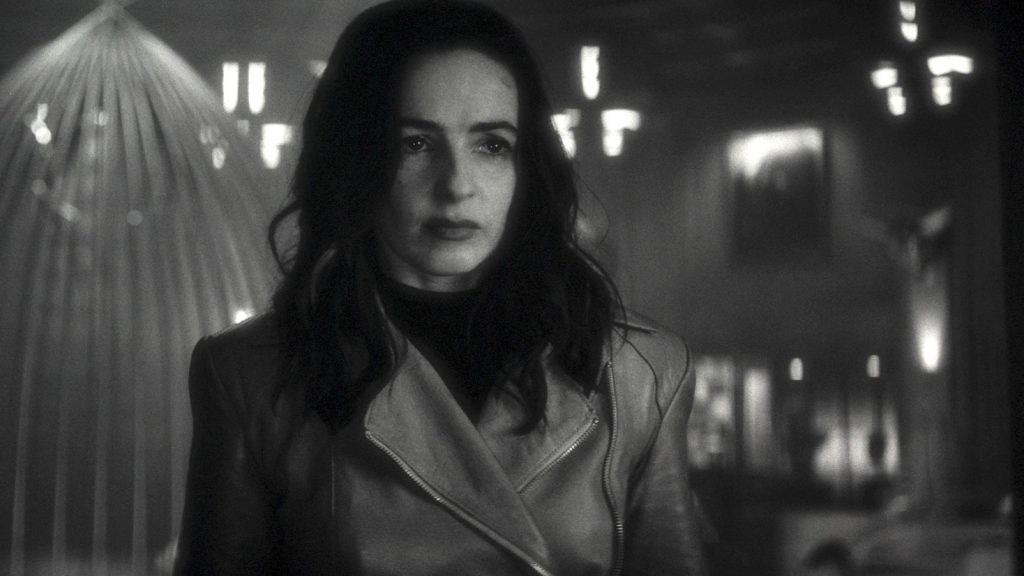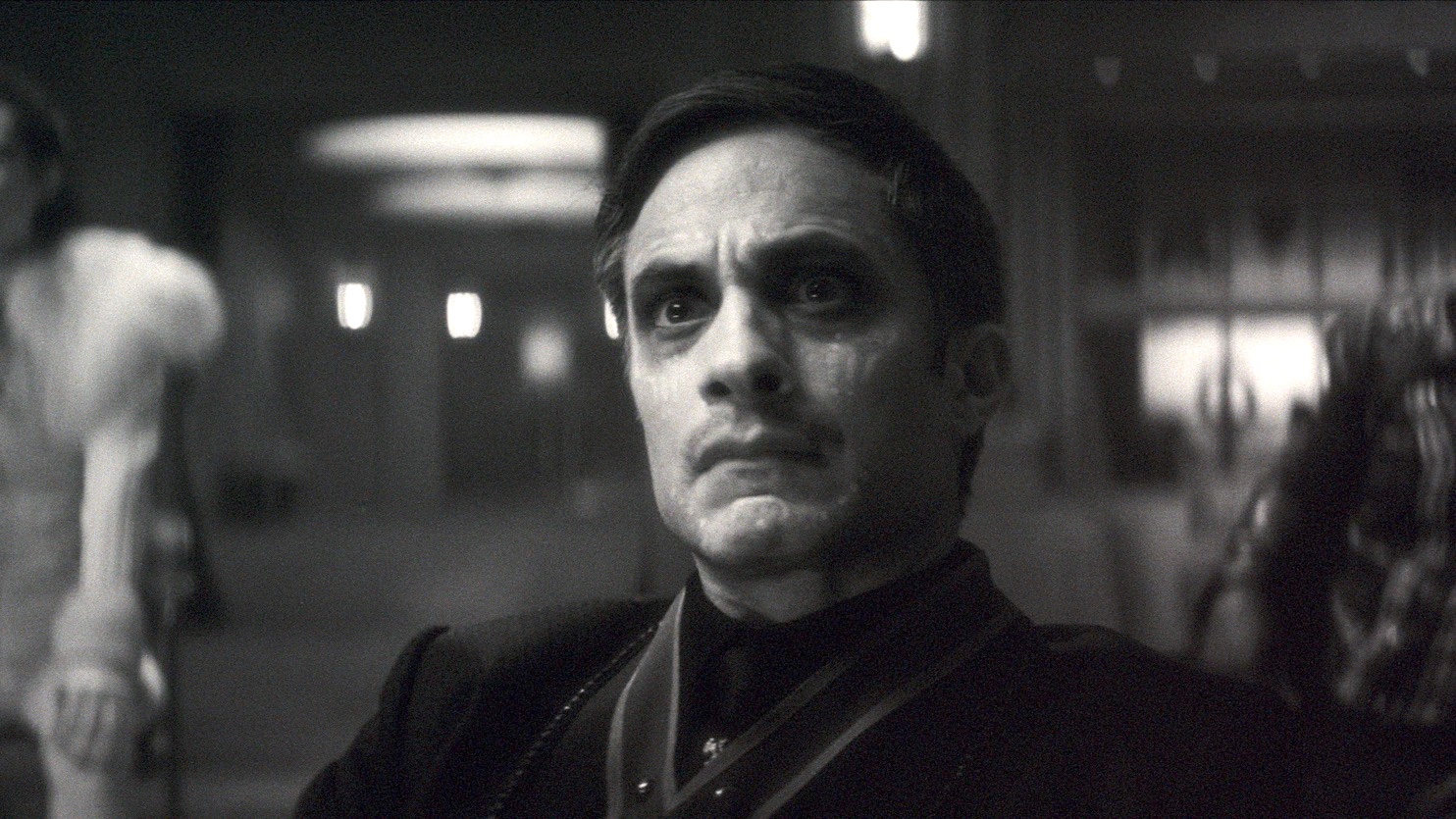The first thing that audience will notice about Werewolf By Night is the black and white aesthetic paying homage to the early horror movies of the 1930s and 1940s. It all began when Marvel’s precursor, Atlas Comics published a short story in 1953 about lycanthropes, appropriately called Werewolf By Night.
The Werewolf By Night character made two appearances in the Marvel Comics – the first as Jack Russell in 1972 and the second as Jake Gomez in 2020. The former incarnation of Jack is portrayed by Gael García Bernal in the current telemovie version co-penned and co-produced by Heather Quinn (Hawkeye, Moxie). Quinn spoke to us about her working collaboration with director and music man, Michael Giacchino (Thor: Love And Thunder, Lightyear).
“I thought Mike [Giacchino] had a vision of them [early Universal horror movies]. But to be honest, the driving force was getting to the emotional side of the character so that people care,” said Quinn. The history of werewolves was carefully blended into Jack Russell’s character to flesh him out. The main creative challenge was how to tell a werewolf story that’s been told many times in a new and fresh way by paradoxically giving it a throwback feel. Giacchino is mainly known in the film world as a composer, so he’s well-versed in modulating emotion through music.

Heather Quinn
Heather Quinn had her first brush with the Marvel Comic Universe (MCU) while she was working on Hawkeye. “The studio asked me to pitch on Werewolf By Night with Michael Giacchino.” Although not a total devotee of lycanthropes, Quinn was attracted to the excitement of the relationship between Jack Russell and Elsa Bloodstone (Laura Donnelly) who led the hunters at the Bloodstone Temple. “I loved the idea of getting to introduce monsters into the MCU. What a privilege! What a pressure!,” Quinn exclaimed. “I liked the voice and tone of this territory of the Marvel universe. I liked the idea of writing characters that were meant to be enemies.” She also tested the common trope of whether monsters were always bad and heroes always good. This was examined in Jack Russell’s character which exuded some sort of warmth and innocence to his monsterhood. “It’s more difficult to judge him badly.”
Adapting any Marvel property is a challenge, even the lesser known ones. “It’s a blessing and a curse when you have so much werewolf history in general. There are certain pillars you have to include. There’s also so much in the comics that you also need to keep in mind.” Apart from being a werewolf, Jack Russell also had to navigate the discomfort of having a hidden identity. “We didn’t necessarily focus on Jack being a werewolf, but more, on some metaphors we could understand about him on a human level… when people need to hide shameful secrets or live in secret to protect themselves when people are feared because of who they are.”
Fifty-Three Minutes. So Much Story. So Little Time.
Werewolf By Night was only fifty-three minutes long, far less than a typical feature film, so the writers didn’t enjoy the luxury of extensive character explorations. Hard choices had to be made regarding the best way to convey these emotions rapidly and efficiently. “It was more emotional than spectacular.” Characters needed to be introduced quickly, “You have to get what moment of their lives they’re in and how they feel about it right away.”
The writers had a lot to pack into their mini-movie. “We had to introduce three new characters, monsters, a history of the world, an unlikely alliance, and a relationship you need to care about.” The writers needed to know everything about their characters, but only had a few moments that encapsulate them. “You can’t put everything on the screen. You have to select the two or three lines the audience gets and are specific enough for them to buy in.”
Apart from the Werewolf By Night comics, Giacchino and Quinn looked to the Carnival Of Fear comics for guidance. Jack Russell gets thrown into a cage by this Swami at a circus and Jack thinks he’s safe because he doesn’t realize this man has the power to change him into a werewolf as part of freakshow. Revealing Jack’s most shameful secret to the public was considered entertainment.

Elsa Bloodstone (Laura Donnelly) Photo courtesy of Marvel Studios
“We thought this was so dark and so disturbing. We played with the idea of what if Jack doesn’t have control of when he turns into a werewolf. How does he live a human and monster so as not to cause harm?”
The use of mythology in storytelling has long been used as a metaphor for the human experience. Monsters, including werewolves have been used to confront our fears – of change, the unknown, and external danger in an entertaining way. “The things I’m really drawn to are things inside you that you’re born with such as inherited trauma. Some things we’re able to hide and some we’re not.”
Generational trauma is simple to explain, but it’s exaggerated in a myth
Jack Russell struggles with his isolation. “He ponders whether the can loved the way he is?” What does it mean to be feared and judged for being a werewolf? Who will accept you? Ultimately, it poses the question of what it means to be a monster. Does being different make you a monster? Is Jack more human or more werewolf? These answers are left to the audience to answer.
Beyond The Source Material
Team Quinn and Giacchino had a mountain of comics to distill into their movie. They naturally started with all the Werewolf By Night comics. They also studied the Man-Thing, Bloodstone and Monsters Unleashed comics for inspiration. “We were looking more for moments and feelings that pop out rather than plot,” said Quinn. “The feeling of Jack Russell getting transformed into a werewolf by somebody else’s power, generated the plot for us.”
They also read The Danger Game comics which are about a big game hunter Joshua Kane who’s got bored hunting animals, so he brings Jack to a studio lot so he could hunt him. “It’s creepy. dark, evocative, and very personal. We wanted to capture Joshua’s spirit of Jack being a monster being reason enough to be hunted.”
The source material was no doubt dark and discomforting. Such actions may easily be sent to the archives of time, but the spirit of persecuting perceived monsters is as current today as it was then. Sifting through a barrage of comics to help shape their story, Giacchino and Quinn sorted them into YES and NO piles. They created a hunter called Joshua based on The Danger Game comics. They avoided using too much from the Youngblood comics because Elsa had too much of a cartoonish look. “We asked what do we like from this, what makes sense, what are letting go of?”
Heather Quinn deliberately avoided reading too many comments from fans during the development stage so she wouldn’t become overwhelmed. She just focused on the story. “I don’t even try to think about the fact that I was writing a Marvel film,” she confessed. “I started with the emotion and slowly brought in the werewolf pieces. You can’t make choices that will betray the lore or the love of the comics. We celebrate them. If you’re going to break rules or go against them, you need to be very intentional about it and respecting the history and the artists that came before you. I thought about it as the truth of Jack Russell. I didn’t want to be in too big of an echo chamber.”
One of the most significant, albeit substantial departures from the comics is that, “Jack Russell is not as super bothered, ashamed and tortured by being a werewolf in the film. Although there’s still darkness and pain, he’s come to terms with it.“
